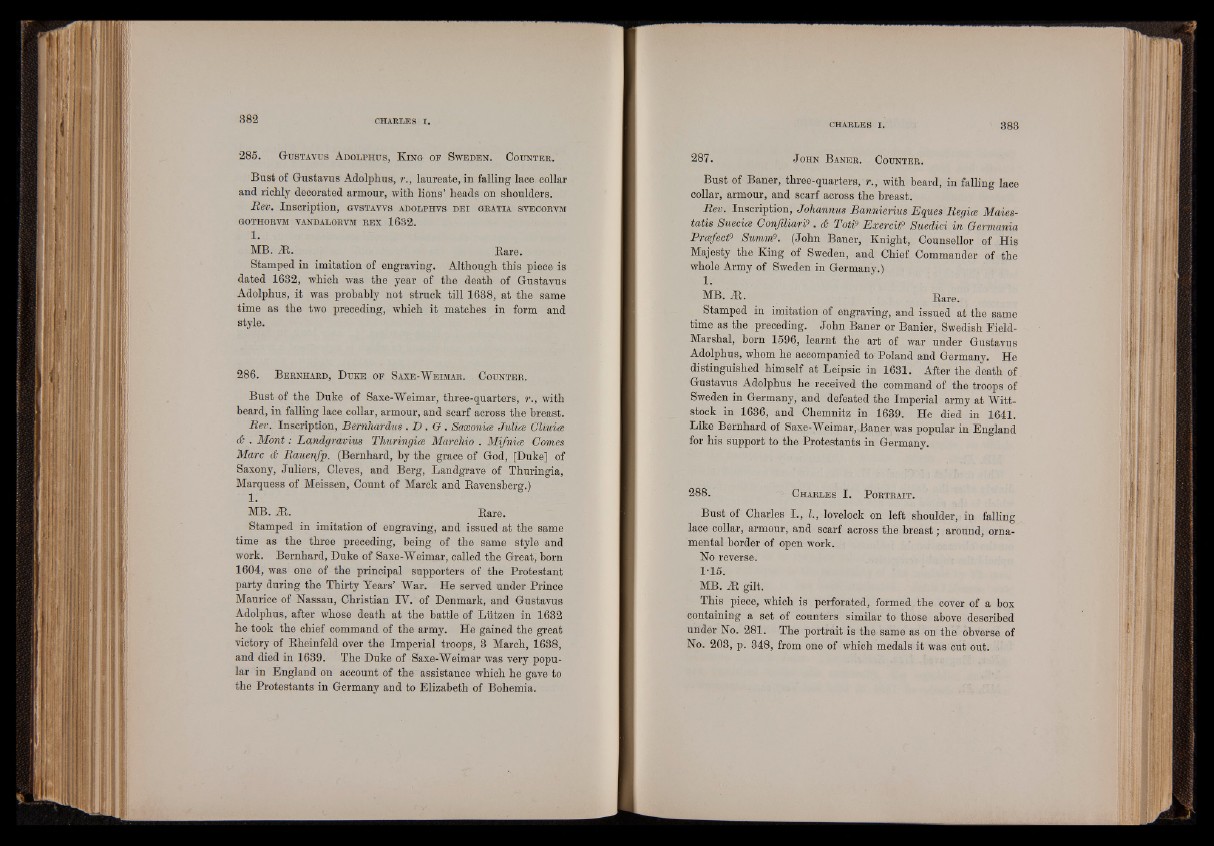
285. G u s t a v u s A d o l p h u s , K i n g o f S w e d e n . C o u n t e b .
Bust of Gustavus Adolphus, r., laureate, in falling lace collar
and richly decorated armour, with lions’ heads on shoulders.
Rev. Inscription, g v s t a w s a d o l p h v s d e i g r a t i a s v e c o r v m
GOTHORVM VANDALOBVM BEX 1632.
1.M
B. Æ. Bare.
Stamped in imitation of engraving. Although this piece is
dated 1632, which was the year of the death of Gustavus
Adolphus, it was probably not struck till 1638, at the same
time as the two preceding, which it matches in form and
style.
286. B e r n h a b d , D u k e o f S a x e -W e im a r . C o u n t e r .
Bust of the Duke of Saxe-Weimar, three-quarters, r., with
beard, in falling lace collar, armour, and scarf across the breast.
Rev. Inscription, Bemhardus . D . G . Saxonice Julia Cliuia
& . M ont: Landgravius Thuringia Marchio . Mifnia Comes
Marc & Rauenjp. (Bernhard, by the grace of God, [Duke] of
Saxony, Juliers, Cleves, and Berg, Landgrave of Thuringia,
Marquess of Meissen, Count of Marck and Bavensherg.)
1. MB. iB. Bare.
Stamped in imitation of engraving, and issued at the same
time as the three preceding, being of the same style and
work. Bernhard, Duke of Saxe-Weimar, called the Great, born
1604, was one of the principal supporters of the Protestant
party during the Thirty Years’ War. He served under Prince
Maurice of Nassau, Christian IY. of Denmark, and Gustavus
Adolphus, after whose death at the battle of Liitzen in 1632
he took the chief command of the army. He gained the great
victory of Bheinfeld over the Imperial troops, 3 March, 1638,
and died in 1639. The Duke of Saxe-Weimar was very popular
in England on account of the assistance which he gave to
the Protestants in Germany and to Elizabeth of Bohemia.
287. J o h n B a n e r . C o u n t e r .
Bust of Baner, three-quarters, r., with beard, in falling lace
collar, armour, and scarf across the breast.
Rev. Inscription, Johannus Bannierius Eques Regia Maies-
tatis Suecia Confdiari9 . é TotiP ExerciP Suedici in Germania
Prafect? SummP. (John Baner, Knight, Counsellor of His
Majesty the King of Sweden, and Chief Commander of the
whole Army of Sweden in Germany.)
1.
MB. Æ,. Bare.
Stamped in imitation of engraving, and issued at the same
time as the preceding. John Baner or Banier, Swedish Field-
Marshal, born 1596, learnt the art of war under Gustavus
Adolphus, whom he accompanied to Poland and Germany. He
distinguished himself at Leipsic in 1631. After the death of
Gustavus Adolphus he received the command of the troops of
Sweden in Germany, and defeated the Imperial army at Witt-
stock in 1636, and Chemnitz in 1639. He died in 1641.
Like Bernhard of Saxe-Weimar, Baner was popular in England
for his support to the Protestants in Germany.
288. ■ C h a r l e s I. P o r t r a i t .
Bust of Charles I., I., lovelock on left shoulder, in falling
lace collar, armour, and scarf across the breast; around, ornamental
border of open work.
No reverse.
1-15.
MB. gilt.
This piece, which is perforated, formed the cover of a box
containing a set of counters similar to those above described
under No. 281. The portrait is the same as on the obverse of
No. 203, p. 348, from one of which medals it was cut out.